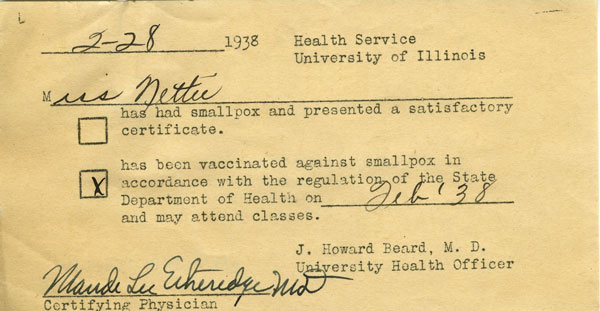This post is part five of the exhibit “Epidemic! Disease on Campus, 1918-1938.”

February 25, 1938
Record Series 33/1/806
In late February of 1938, cities and towns across the state of Illinois showed a marked increase in diagnosed smallpox cases. Ten victims appeared in the Twin Cities and the Director of the State Department of Health A.C. Baxter indicated an impending epidemic for Champaign-Urbana as a result of the new cases. Upon Baxter’s advice, President A.C. Willard directed that all students, faculty, and staff receive vaccination or remain away from campus for 16 days. Notices like the poster located to the right were placed throughout campus.
To meet the immunization demands of the University community, the Health Services Station offered vaccinations to students and staff free of charge. The station stayed open from 7:30am to 10:30pm for nine days and provided a total of 10,619 vaccinations at a cost of $634.79. The executive order and subsequent immunization drive resulted in the vaccination of the entire University population, with the exception of seven individuals who remained away from campus. The reason two employees refused vaccination remains unknown; five students rejected vaccination because of “conscientious scruples against vaccination,” “on account of having had eczema when a child,” “advised by family physician, an osteopath, to refuse vaccination,” and religious conviction as Christian Scientists.[1]

Record Series 2/9/1
Note: document altered to protect patient privacy.
A total of 20 cases of smallpox occurred in Champaign-Urbana: seven adults, two Champaign senior high school students, three Champaign junior high school students, seven grade school students at Colonel Wolfe, and one unknown. No University or Urbana cases occurred.[2] With over 20,000 grade, high school and University students vaccinated in a little over one week, the prompt response by medical authorities stopped the impending epidemic.[3]
Although English physician Edward Jenner demonstrated the effectiveness of cowpox to protect humans from smallpox in 1796, only after vaccination campaigns throughout the 19th and 20th centuries did the World Health Organization certify the eradication of smallpox in 1979.
[1] President Arthur C. Willard General Correspondence, Record Series 2/9/1, box 31, folder “Small Pox Epidemic,” University of Illinois Archives.
[2] “Discover 7 New Smallpox Cases,” Daily Illini, March 5, 1938.
[3] “No New Smallpox Cases Reported,” Daily Illini, March 2, 1938.